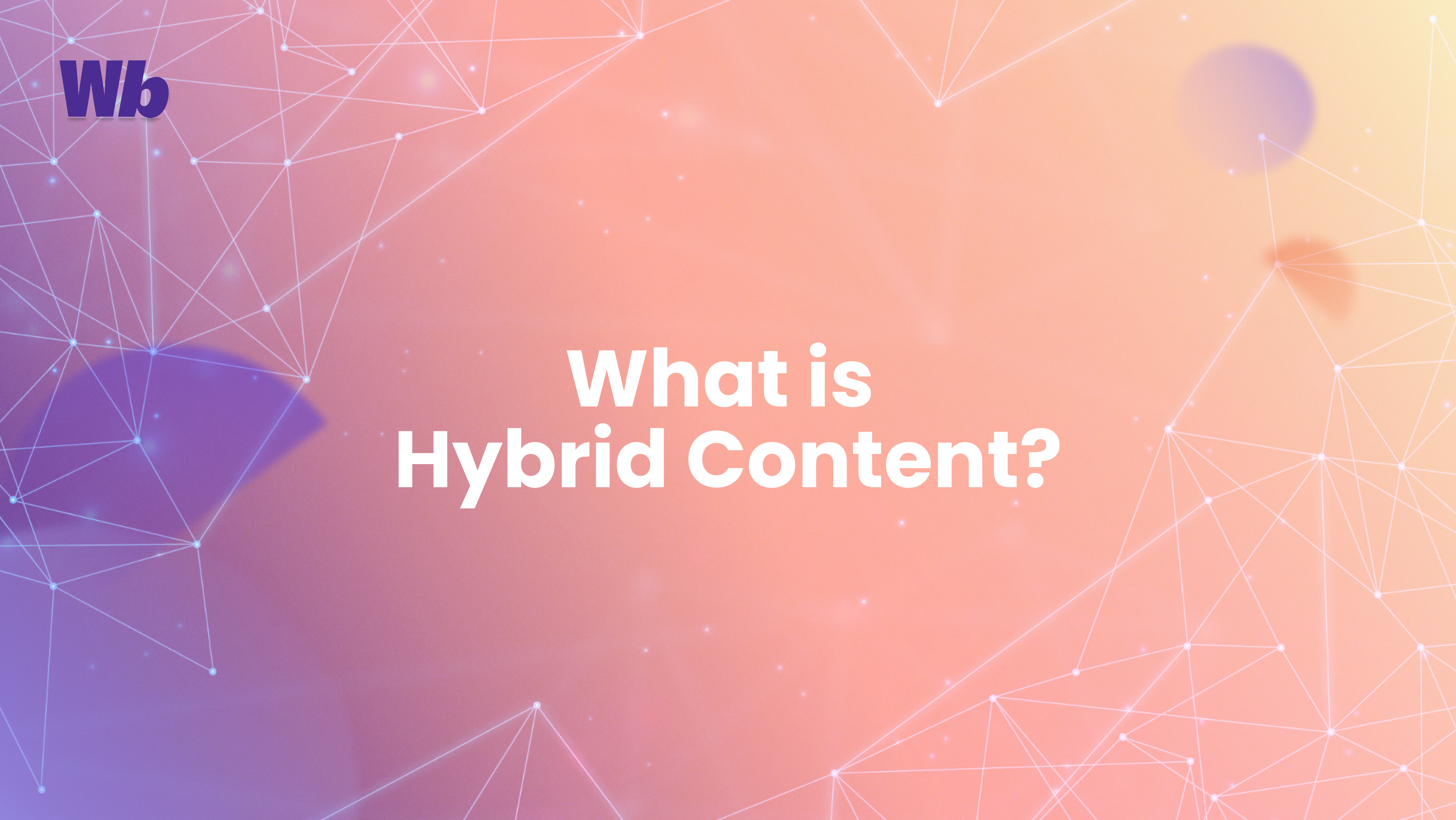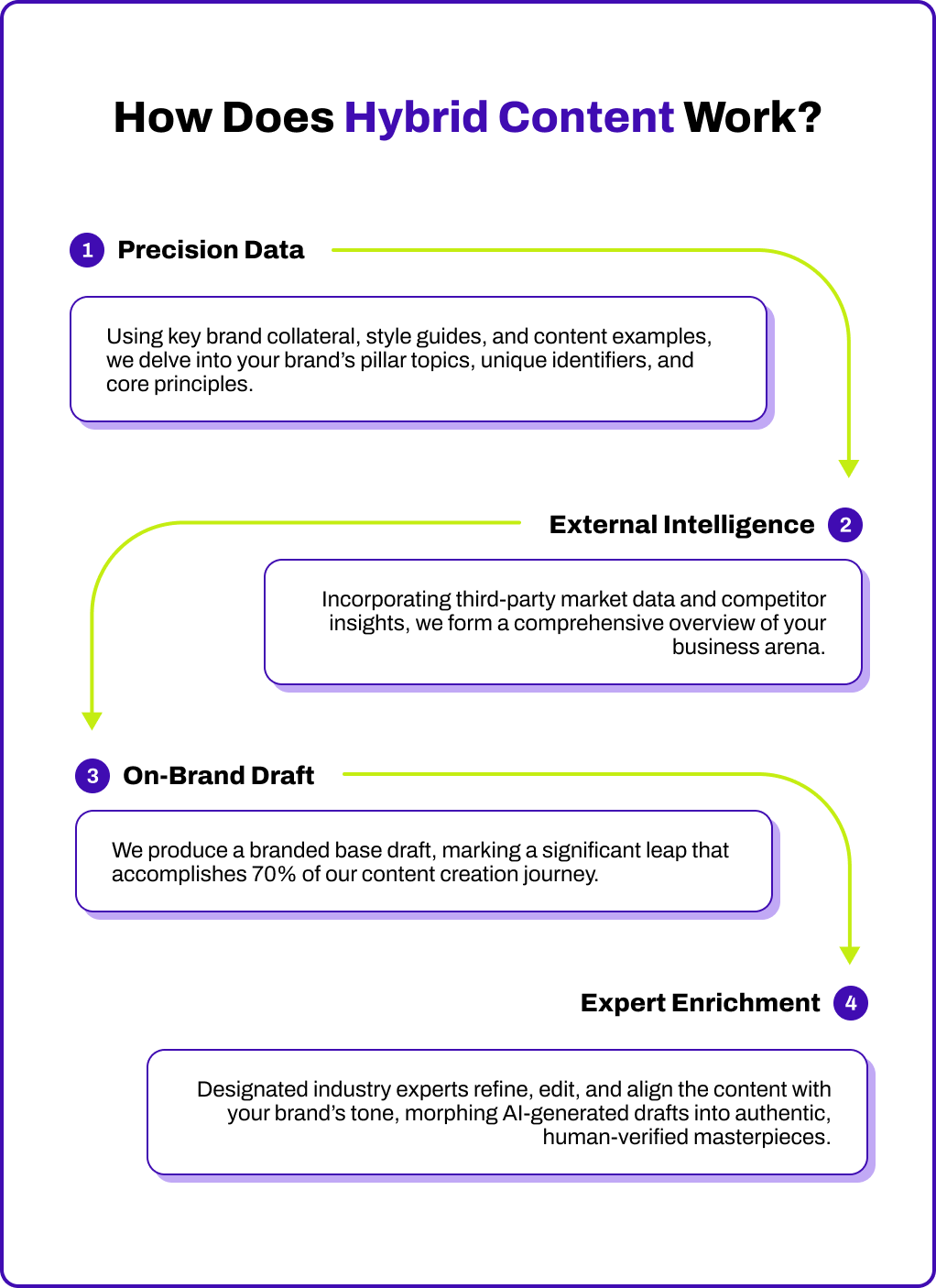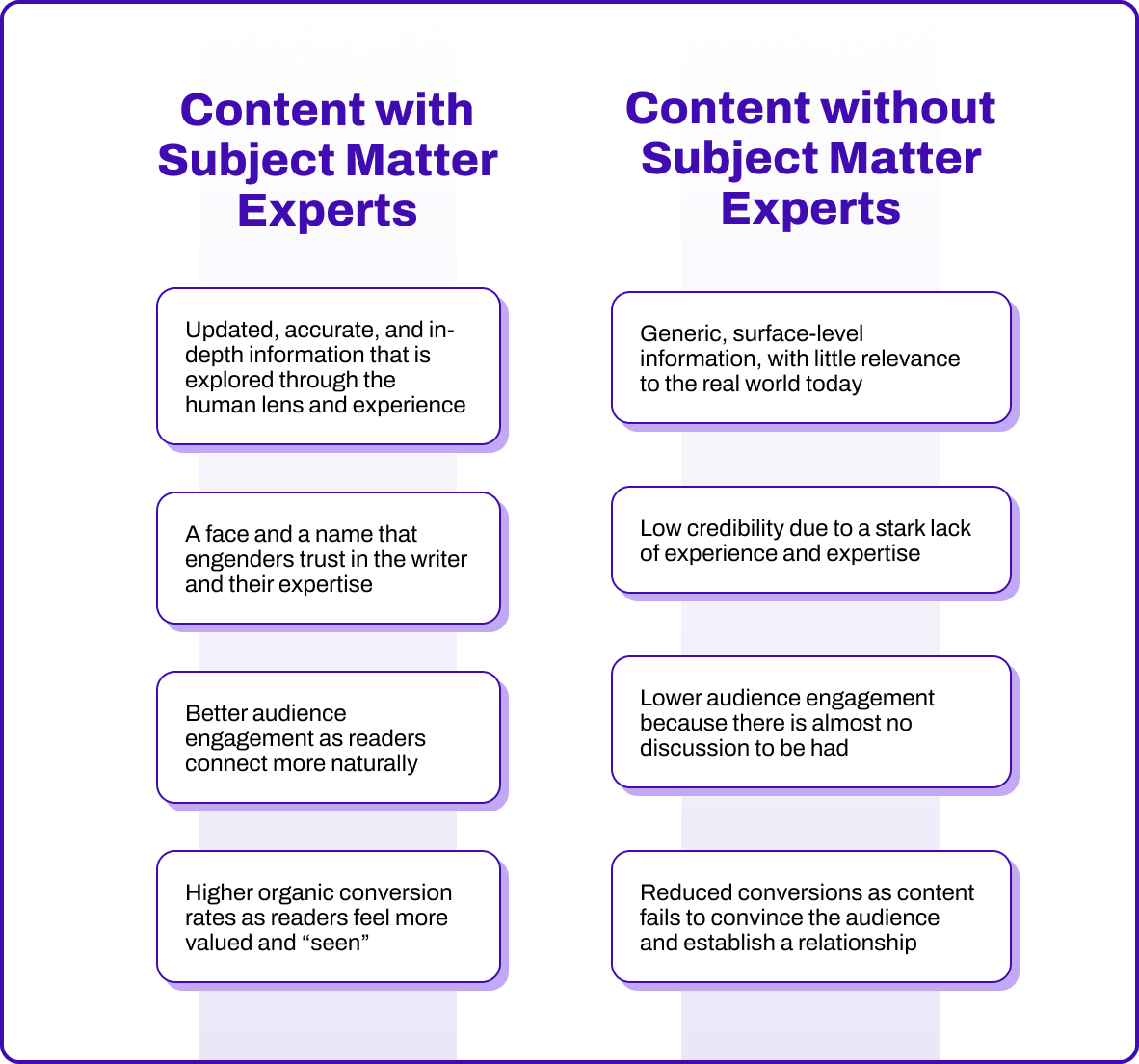Table of Contents
- Home
- »
- Hybrid Content
- »
- How to navigate the AI revolution with hybrid content
-
Stacy Garrels
- 6 minutes read time
How to navigate the AI revolution with hybrid content
- Home
- »
- Hybrid Content
- »
- How to navigate the AI revolution with hybrid content
How to navigate the AI revolution with hybrid content
Table of Contents

In a world where generative AI technology is rapidly transforming industries, content creators are caught at a crossroads: should they embrace AI or not? We at Wordbrew say, why not both?
In response to this dilemma, we’ve pioneered a content marketing category called the ‘hybrid content creation’ method—revolutionizing the content marketing landscape in the process.
Let us guide you through the hybrid method: what it entails, how it operates, and why it should be a part of your content strategy. We’ll explain how generative AI works, the importance of human expertise, and how to harness hybrid content to your brand’s advantage.
What is hybrid content?
Hybrid content is the fusion of generative AI and human intellect, resulting in a unique blend of content that stands unrivaled in the digital arena.
AI generates a comprehensive base draft
Armed with extensive research, competitor insights, and style guidelines as its blueprint.
⬇️
Human subject matter experts edit and refine
Infusing up-to-date research, thought leadership, and a nuanced understanding that resonates more effectively with your audience.
With its vast data processing capability, what makes this model truly beneficial is that AI can create a first draft in minutes, slashing the content creation timeline from weeks to hours—without compromising on quality.
How does hybrid content work?
Hybrid content elevates the content creation process by bridging the gap between AI capabilities and human expertise. Our multi-step process goes beyond traditional content creation, offering smarter, more intuitive, and impactful narratives tailored to your brand.

What makes hybrid content a winner?
1. Speed: If history taught us anything, machines can process and produce almost anything in greater volume and less time than humans.
2. Consistency: AI also doesn’t have emotions (yet), but it can be relied on to deliver uniformity in brand messaging, tone, and style across different platforms.
3. Quality: This is where the subject matter experts (SMEs) come in. They critically enhance the AI-produced base draft content by adding context, nuance, and original insights, thereby increasing its value.
4. Scalability: Delegate the monotonous steps of content creation to AI, and your team is finally free to focus on strategic thinking and growing your business.
Why are subject matter experts important in hybrid content creation?
The short answer? They do what AI can’t. Subject matter experts lend authenticity, depth, and insight that AI struggles to replicate.
AI content enriched with human subject matter expertise is far superior to content created without. Here’s the long answer:

SMEs are crucial in the hybrid content creation process because they bridge the gap between what AI knows and what readers really want to see.
To use a baseball analogy, using AI alone gets you to first base—but with the hybrid method, you will score a home run, with ready-to-publish content to prove it.
Bonafide experts go beyond adjusting grammar and checking facts—they are instrumental in interpreting AI-generated content, adding nuance, and integrating real-world context. With their expertise, they can steer content toward piquing audiences’ interest, creating an environment for meaningful discussion and connection.
Take all of the above and combine it with AI’s sheer processing power and efficiency, and you’ve got a content creation process that is robust, scalable, and engaging.
Creating quality hybrid content
AI is many things, but it’s not a mind reader. You need to teach it your language, just as you would a new team member, for example. So if you’re stuck on what kind of information to give it to produce the best outcome, start with the following:
- Tone of voice guidelines: If you don’t already have these in place, check out our article on Setting Up Your Brand Voice. Essentially, imagine your brand was a person. How would they speak? Define this voice for your AI, and it’ll communicate as an extension of your brand’s personality.
- Writing style: Again, just like people, your brand is sure to have a distinctive way of expressing itself. You might prefer short, punchy sentences or long, flowing prose. This also includes the nitty-gritty grammar points like US versus UK English, how you like to structure your paragraphs, or when to use bullet points.
- Personas: AI needs to know who it’s talking to and what their pain points are. Feed it things like demographic data and buyer profiles so that it can tailor the content to their needs.
Bear in mind this isn’t merely about setting rules for AI—it’s about coaching it to embody your brand, producing content as consistent, engaging, and aligned with your brand as your own work.
Take Wordbrew for instance: we’ve developed a tailored language model that absorbs all crucial brand elements. What’s more, it goes the extra mile by layering in supplemental information and generating content that doesn’t just mirror your brand, but is complete with a human touch for an expert finesse.
How to bring hybrid content into your content strategy
Integrating hybrid content into your current flow could be the key to supercharging your content efforts.
Here’s a step-by-step process to help you get started:
- Define what you want to achieve
As with any strategy, you must start by identifying what goals, hopes, and dreams you have for your content. Perhaps it’s building brand equity, generating leads, or improving customer retention rates. Clear, actionable goals will not only guide your hybrid content creation process but also help you measure its success later.
- Nail down the metrics you need to track
Impressions and pageviews are a great starting point, but they shouldn’t be the only thing you track to measure content performance. Have you considered engagement metrics for audience interaction, such as likes, comments, and shares, for social media platforms? Or conversion metrics for website content, like click-through rates, bounce rates, and conversion rates?
- Bring in the experts
As we’ve already made clear, the value of human expertise in the hybrid content process cannot be overstated. So, make sure you have subject matter experts on board who can take your AI-generated drafts and make them superior.
- Keep your guidelines on hand
If you haven’t already, develop comprehensive guidelines to maintain brand consistency throughout your hybrid content. As mentioned above, these guidelines should cover everything from the voice and writing style to understanding the needs and preferences of your target audience. Sure, it can be arduous, but it will pay off in the long run when AI learns to produce content aligned with your brand’s identity.
- Be ready to pivot according to performance
The process doesn’t end once your hybrid content is live—that’s only the beginning! Make sure you help it reach its audience with a killer content distribution strategy, keep monitoring its performance, and use the data to continually improve your process.
The future of hybrid content
Some say AI will be a passing trend—we say otherwise.
With advancements in AI moving at lightning speed, and as people learn more and more about its potential, businesses are already beginning to cash in on the vast benefits of a hybrid content strategy.
As AI technology evolves, we’ll likely see an even greater synergy between humans and AI in content creation. Machine learning algorithms are continually improving, becoming better at understanding and replicating human language patterns.
At the same time, businesses are also learning how to better utilize their human teams in the hybrid content creation process. That means shifting the focus away from data analysis and repetitive tasks, and towards tasks that humans excel at, such as strategic planning, creative thinking, and emotional understanding.

Parting thoughts
Hybrid content—the strategic blend of AI technology and human expertise—is revolutionizing the content creation landscape right before our eyes, and it’s worth keeping up with it.
If businesses can maintain an open mind and learn to harness the strengths of both AI and humans, they can create high-quality, personalized content at scale, while significantly reducing production time and costs. We’re already seeing the results.
Don’t forget the subject matter experts, who will continue to play a critical role in this process. In a sea of poorly written, surface-level copy, human-enhanced content will stand head and shoulder above the crowd in terms of authenticity, engagement, and conversions.
What do you say, ready to embrace the future of hybrid content? Wordbrew is leading the content creation space in a post-AI world—get in touch to talk strategy today.